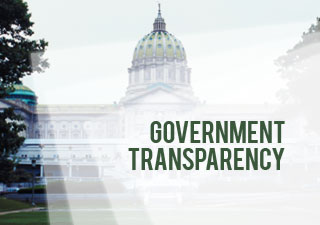Fact Sheet

Spending Transparency & Accountability
There is a national movement to make government spending and finances accessible to taxpayers. Pennsylvania lags behind, but state lawmakers are moving toward greater transparency.
Transparency and the State Budget Process
- To hold government officials accountable, citizens must have a source of reliable information.
- As investors would demand adequate information about the performance of a business, so too do taxpayers deserve adequate information about where their dollars are spent.
- Recent budget impasses illustrate the importance of spending transparency. Negotiating billions of dollars of spending across dozens of agencies and departments and thousands of line items requires that policymakers and the public understand how money is being spent.
- Transparency is a means to an end: an informed budget debate that prevents corruption.
- Rep. Bill DeWeese opined corruption, like using taxpayer-funded bonuses and technology for political campaigns, would have been prevented with greater spending transparency.
- Effective transparency requires a single thorough and searchable website with easy navigation and aggregation.
- Three bills to create a spending database have been introduced: SB 105 (Sen. Pat Browne), HB 1460 (Rep. Jim Christiana), and HB 1880 (Rep. Rick Mirabito).
Transparency in Pennsylvania
- Pennsylvania features a smattering of online resources, such as a database of some Department of Community and Economic (DCED) grants, and the Treasurer’s eLibrary for state contracts.
- However, these tools are difficult to use, do not offer a central location for spending information, and only cover a fraction of state spending. Even rank-and-file legislators do not know what many budget line-items fund.
- The House State Government Committee recently passed HB 1880, which would create an online database of expenditure information of all state agencies, including salaries, audits, and contracts.
- Details would include the total amount, recipient, funding source, budget line, performance measures, and other information.
- Transparency also makes other budgetary reforms possible, such as performance-based budgeting.
- Performance-based budgeting, in contrast to the current process, would increase programs’ and departments’ funding based on performance, rather than lobbying or politics.
- Rep. Karen Beyer has a proposal to use zero-based budgeting, a type of performance-based budgeting that would require justification of a government program’s entire budget every five years.
Spending Databases and Transparency across the Country
- In 2006, the federal government created an online spending database to provide information of all contacts and grants over $25,000.
- Twenty-six state legislatures have passed legislation to create spending databases.
- Apart from legislative action, governors in 11 states have issued executive orders implementing fiscal transparency.
- Opponents point to the cost of creating databases, but evidence show they cost little and save money in the long run.
- A 2009 study by the Mercatus Center found the average state database costs $140,000, and nine states created sites without any new appropriations.
Transparency Offers Cost Savings to Taxpayers
- Better information fosters competition for government contracts and efficient use of state money. Allowing citizens to evaluate performance for expenditures could reduce wasteful spending.
- Texas consolidated contracts and services with $4.8 million in realized savings. Watchdogs using Missouri’s MAP portal questioned over $1.5 million in spending.
- Transparency could decrease the amount of paperwork for state employees if all spending data is centralized.
- Pennsylvania’s Open Records Law is a good start, but the cost (both money and time) of finding spending info can discourage citizens from filing requests.
- The executive director of the Pennsylvania Office of Open Records, Terry Mutchler, estimated right-to-know requests could fall by 30%.
Independent Fiscal Office
As part of the 2009 budget deal, Pennsylvania lawmakers created an Independent Fiscal Office (IFO). The IFO would:
- Analyze the executive budget, provide revenue estimates for five years, and collect expenditure records and budget requests from the executive departments and agencies.
- Develop a baseline budget, assuming increases to current programs based on population, inflation, and demand growth.
- Dynamically score proposed tax changes based on econometric models – evaluating the impact on behavior and economic growth. Dynamic modeling is not done in the current budget process.
- Feature a director, appointed to a six-year term by a committee of legislative leaders and the governor.
- Develop performance measures for state programs and agencies, and conduct outcome-based evaluations based on these measures.
- The value of the IFO could be increased by utilizing performance-based budgeting or sun-setting all programs subject to a performance review
# # #
For more on Spending Transparency, visit www.CommonwealthFoundation.org